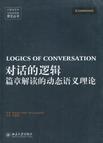对话的逻辑
出版时间:2010-8 出版社:北京大学出版社 作者:埃舍,莱斯卡里达斯 著 页数:526 字数:810000
Tag标签:无
内容概要
人们如何使用语言与理解含义,牵涉的层面不仅只是词汇本身的意义与组合词句的意义而已。尤其是对话中的语言使用,由于涉及多人之间的沟通,因此对万事万物的感官与感觉,事物发生的逻辑关连性,语言使用者的共有知识以及彼此是否有共同的信念等因素都必须一并考虑,才能确保对话能如愿如理的进行。形式语义学将词句的语言含义以符号与运算,定义定理与规则,也同时把词句间的篇章相关性呈现出来。这是很好的方法。解析篇章结构的理论(Hobbs 1985, Grosz and Sidner 1986, Mann and Thompson 1988, Kamp and Reyle 1993 etc.)应用在对话语体时,有时缺少能动态调整的弹性。本书所提出的语段篇章表述理论(Segmented Discourse Representation Theory, SDRT) 是篇章表述理论(Discourse Representation Theory, DRT) (Asher 1993)的延伸。也是一个能与动态语义理论架构相结合的形式逻辑理论,定义清楚而且可以应用于对话互动的形式语义模型。
书籍目录
导读 preface figures acknowledgements 1 motivations 1.1 what this book is, and is not, about 1.2 motivating rhetorical relations 1.3 rhetorical relations in corpora 1.4 conclusions 2 semantic models of discourse interpretation 2.1 introduction 2.2 dynamic semantics 2.3 drss:syntax and semantics 2.4 construction and underspecification 2.5 why dynamic semantics is not enough 2.6 conclusion 3 pragmatic models of discourse interpretation 3.1 introduction 3.2 traditional theories of pragmatics 3.3 cognitive approaches to discourse interpretation 3.4 other theories that use rhetorical relations 3.5 empirical approaches to discourse interpretation 3.6 some concluding remarks 4 the logical form of discourse 4.1 introduction 4.2 underspecification and pragmatic supplementation 4.3 underspecified logical forms for clauses 4.4 the syntax of the discourse language 4.5 a language for describing logical forms 4.6 the vocabulary of discourse relations 4.7 hierarchical structure and availability 4.8 the logic of information content 4.9 unpacking the truth conditions: an example 4.10 introducing holes into discourse structures 4.11 conclusion 5 building logical forms for discourse 5.1 introduction 5.2 filling in holes 5.3 the glue language 5.4 some formal details 5.5 transferring information into the glue language 5.6 some default rules for inferring discourse relations 5.7 inferring discourse relations: some examples 5.8 putting the pieces together: sdrs update 5.9 working through a bigger example 5.10 formulating maximal discourse coherence 5.11 interpreting presuppositions 5.12 conclusions 6 the lexicon and discourse structure 6.1 introduction 6.2 what is in the lexicon? 6.3 lexical semantics in review 6.4 lexical information to discourse structure 6.5 from discourse structure to lexical interpretation 6.6 conclusion 7 discourse relations for dialogue 7.1 introduction 7.2 why dialogue and monologue are similar 7.3 some differences between monologue and dialogue 7.4 sdrt and speech acts 7.5 technical details of sdrt for dialogue 7.6 simple relations for dialogue 7.7 conclusions 8 disputes in dialogue 8.1 introduction 8.2 some motivating examples 8.3 correction: the analysis of one divergent relation 8.4 settledness 8.5 an analysis of an extended example 8.6 conclusion 9 cognitive modelling 9.1 introduction 9.2 cognitive modelling for discourse interpretation 9.3 from cognitive models to discourse structure 9.4 axioms for discourse relations based on structure 9.5 applications 9.6 more implicatures:turn taking 9.7 conclusions 10 some concluding remarks 10.1 what we've done 10.2 the dynamic i.ogic of information content 10.3 semantic underspeeification 10.4 discourse update 10.5 the logic of the lexicon 10.6 the logic of cognitive modelling 10.7 comparison with other theories 10.8 where we go from here a objections and replies a.1 introduction a.2 questions of detail a.3 questions of principle b notation index b.1 information content:object language b.2 information content:metalanguage b.3 underspecified information content:the language lulf b.4 underspecified information content:metalanguage b.5 glue logic: object language b.6 glue logic: metalanguage b.7 discourse update b.8 cognitive modelling language c the semantics of drt d glossary of discourse relations d.1 introduction d.2 content-level relations d.3 text structuring relations d.4 cognitive-level discourse relations d.5 divergent relations d.6 metatalk relations e summary of discourse update e.1 summary of the glue-logic axioms e.2 discourse update definitions f some proofs in the glue logic f.1 the specificity principle f.2 an example involving specificity references index citation index
图书封面
图书标签Tags
无
评论、评分、阅读与下载
